Home canned turkey stock is a delight to add to risottos, sauces and gravies; it adds a wonderful depth of flavour as well as nutrients. You may wish to roast the bones first for an even deeper flavour.
Here we are working with a recipe from the USDA Complete Guide.
See also: Canning Turkey, Canning Chicken Stock .
The recipe
Jar size choices: Either half-litre (1 US pint) OR 1 litre (1 US quart)
Processing method: pressure canning only
Yield: varies
Headspace: 3 cm (1 inch)
Processing pressure: 10 lbs (69 kPa) weighted gauge, 11 lbs (76 kpa) dial gauge (adjust pressure for your altitude when over 300 metres / 1000 feet.)
Processing time: Half-litres (pints) 20 minutes; litres (quarts) 25 minutes.
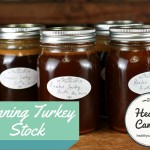
Canning turkey stock
Instructions
- Take turkey carcass, clean all meat off it. (Tip: you can freeze meat in a baggie for adding to soup later.)
- (Optional: Some people like to roast the carcass for an hour or so at this point, for a darker, richer-tasting stock. )
- EITHER : Put carcass in pot with enough water to cover bones. Bring to a boil, simmer for 45 minutes. OR Put in pressure cooker. Add enough water to cover bones. Cook for 30 minutes on high pressure (13 to 15 lbs for most North Americans. See Notes.) A couple bay leaves tossed into either process make an inspired addition. Optionally, you can season with salt or a non-bitter, non-clouding salt sub (such as Herbamare), but, the plainer you leave the stock, the more flexible it will be when you go to use it.
- Strain into a large bowl or tub; have a second go at picking more of the loosened meat off it, add that to your bag of frozen meat, and put the stock in fridge over night.
- In the morning, scrape all the fat off the top; discard the fat and any added bay leaves.
- Reheat the stock to boiling in a pot or a microwave (mind the surge when removing from microwave.)
- Pour hot into half-litre (1 US pint) jars or 1 litre (US quart) jars.
- Leave 3 cm (1 inch) headspace.
- Wipe jar rims.
- Put lids on, put in pressure canner.
- Processing pressure: 10 lbs (69 kPa) weighted gauge, 11 lbs (76 kpa) dial gauge (adjust pressure for your altitude when over 300 metres / 1000 feet.)
- Processing time: half-litre (1 US pint) jars for 20 minutes. OR 1 litre (1 US quart) jars for 25 minutes.
Nutrition
See also if applicable: Dial Gauge Pressures.
Reference information
How to pressure can.
When pressure canning, you must adjust the pressure for your altitude.
For salt substitute, we used Herbamare Sodium-Free as it is non-bitter and non-clouding in canning.
What is the shelf life of home canned goods?
Notes
- You may see some people saying they simmer or boil their bones for stock for 5 or 6 hours. This is a waste of energy, as pressure cooking them for 30 minutes will yield the same results, with a fraction of the energy usage. Should you choose to boil, notice that the USDA suggests that 45 minutes is completely adequate. Any time beyond that has zero benefit to show for it.
- Laura Pazzaglia, author of Hip Pressure Cooking, says that for pressure cooking (note, not pressure canning), HIGH PRESSURE equals 13 to 15 lbs, or 90 to 100 kilopascals, or .9 to 1 bar. [1]Pazzaglia, Laura. Hip Pressure Cooking. New York: St Martin’s Griffin. 2014. Page 12. The pressure cooking time of 30 minutes for poultry stock also comes from the same excellent book, page 48. Note: if you are using an electric pressure cooker to make the stock in, such as an Instant Pot, she advises increasing the time to 33 to 35 minutes.
- Pressure cooking uses less energy and extracts more flavour and gelatin from the bones, resulting in a better quality stock.
- Above all, please do keep clear the difference between pressure cooking the stock to save energy and produce a superior stock, and then pressure canning it later to preserve it.
- When you first roast the turkey, deglaze the roasting pan with a small amount of boiling water from a kettle. Pour that into a tub and let sit overnight in fridge, skim fat off the next day. This will usually be a lovely jelly-like stock. Add that to the batch of stock you are making. If you do roast the turkey carcass, deglaze that roasting pan in a similar way, too.
- Roasting the turkey carcass can result in a wonderful deep rich flavour but also results in a quite dark stock, usually (photos show difference in stocks from roasted and unroasted carcasses.)
- Safety tip: After you have a plate of meat you have picked off a turkey carcass, always take a minute to feel carefully through that meat with your fingers, pressing it all, feeling for small bones. Be particularly mindful of treacherous flat bones from turkey legs.
- A bay leaf or two while you are boiling or pressure cooking the bones will elevate your stock.
- You could add a bit of salt or non-bitter, non-clouding salt sub per jar, but it could be argued that it’s just better to can it as is, then do flavour adjustments when you go to use it in something. Salt adds zero towards the safety of this recipe; it’s just a seasoning here. The safety is the pressure canning process.
Recipe Source
United States Department of Agriculture (USDA). Complete guide to home canning. Agriculture information bulletin No. 539. 2015. Page 5 – 7.
Modifications
- Added bay leaf for flavour;
- Added phase of overnight in fridge to skim fat off.
Nutrition
Per 250 ml ( 1 cup / 8 oz ): 20 calories
Weight Watchers PointsPlus®: 250 ml (1 cup / 8 oz ): 0 points; 500 ml ( 1 US pint / 2 cups/ 16 oz): 1 points.
* Nutrition info provided by https://caloriecount.about.com
* PointsPlus™ calculated by healthycanning.com. Not endorsed by Weight Watchers® International, Inc, which is the owner of the PointsPlus® registered trademark.
* Herbamare ® is a registered trademark of the A. Vogel Corporation.
References

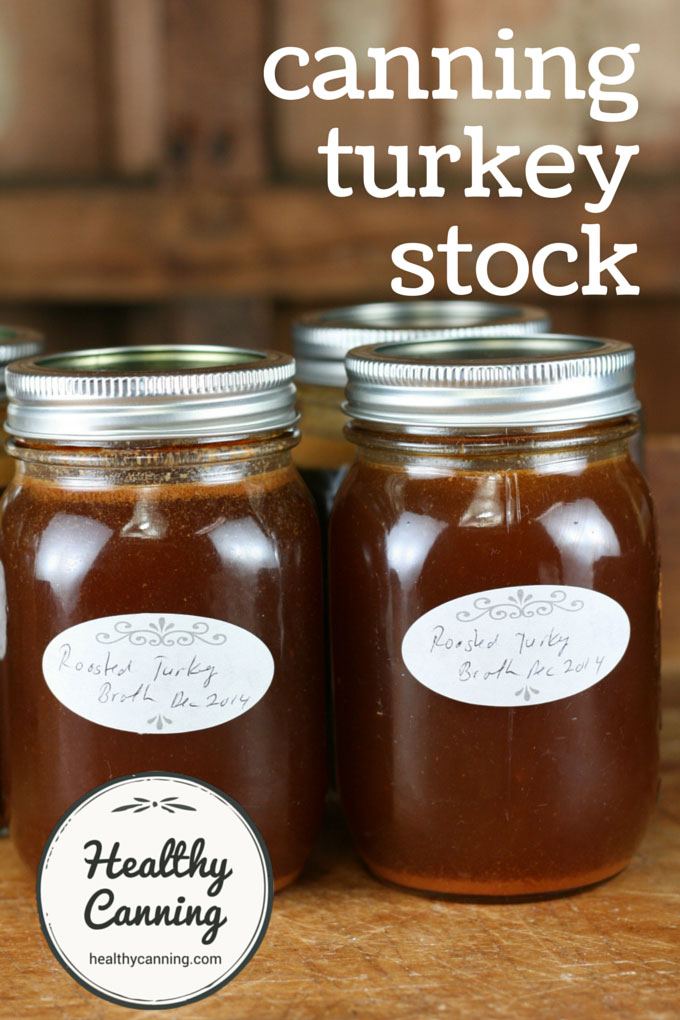

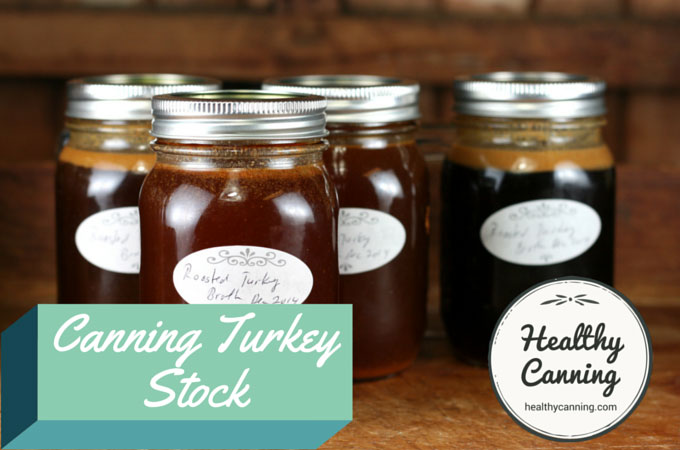
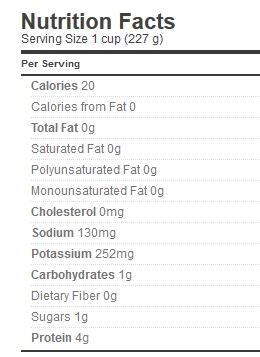
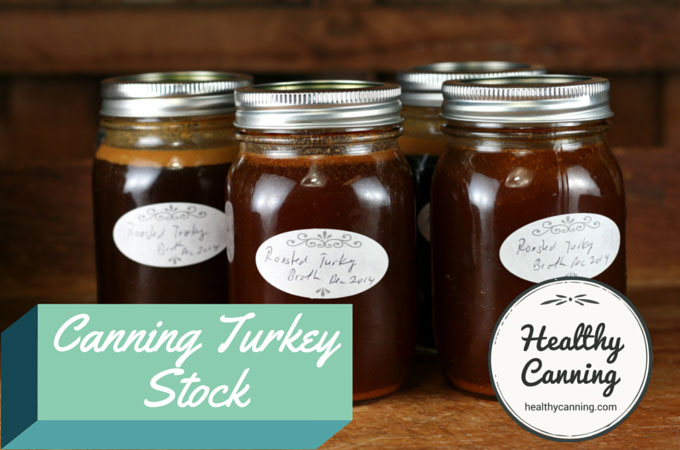
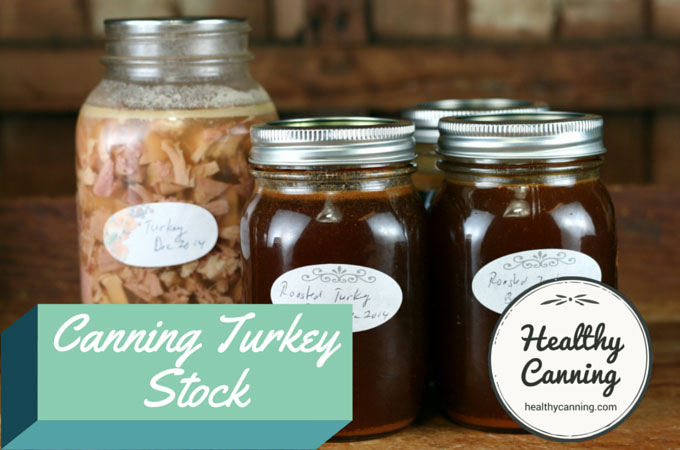
Arlene Fusko
Is it safe to leave some of the fat? I am not looking for fat free and like to have it more flavorful.
Healthy Canning
Typically it’s recommended to remove most of the fat when canning meats, because it can interfere with lids sealing, and it can go rancid on the shelf over time.
Paul Quilty
I love this recipe.but can anybody please tell me if I can seal my jars another way instead of a pressure cooker.thank you Paul
Healthy Canning
No, you cannot. If you do not have a pressure canner, then freeze your turkey stock.